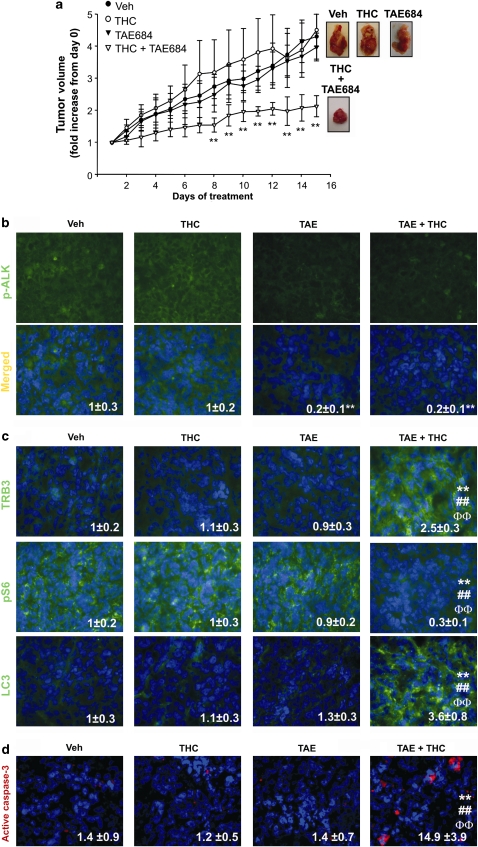Figure 8.
Pharmacological inhibition of ALK sensitizes T98 cell-derived tumors to THC antitumoral action. (a) Effect of NPVTAE684 (TAE; 1 mg/kg per day) and and THC (15 mg/kg per day) treatment on the growth of tumor xenografts derived from T98 cells (mean±S.D.; n=5 for each condition, **P<0.01 from the rest of the treatments). Representative photographs of vehicle-, TAE-, THC- and TAE+THC-treated tumors are shown. (b) Effect of TAE and THC treatment on phospho-ALK immunostaing of T98 cell-derived tumor xenografts. Values inside the photomicrograhs are expressed as the phospho-ALK-stained area relative to the number of nuclei in each field and correspond to 10 fields of three different tumors for each condition. Data are normalized using vehicle-treated tumors as a reference. Representative photomicrographs are shown (mean±S.D.; **P<0.01 from vehicle-treated tumors). (c) Effect of Mdk silencing and THC treatment on TRB3 (upper panel), phospho-S6 (middle panel) or LC3 (lower panel) immunostaining of T98 cell-derived tumor xenografts. Values inside the photomicrographs are expressed as the TRB3-, phospho-S6- or LC3- stained area relative to the number of nuclei in each field and correspond to 10 fields of three different tumors for each condition. Data are normalized using vehicle-treated tumors as a reference. Representative photomicrographs are shown (mean±S.D.; **P<0.01 from vehicle-treated tumors; ##P<0.01 from THC-treated tumors and ΦΦP<0.01 from TAE-treated tumors). (d) Effect of THC on apoptosis of T98 cell-derived tumor xenografts. Values inside the photomicrographs are expressed as the percentage of active caspase-3 positive cells relative to the total number of nuclei in each field and correspond to 10 representative fields of three different tumors for each condition. Representative photomicrographs are shown (mean±S.D.; **P<0.01 from vehicle-treated tumors; ##P<0.01 from THC-treated tumors and ΦΦP<0.01 from TAE-treated tumors)

